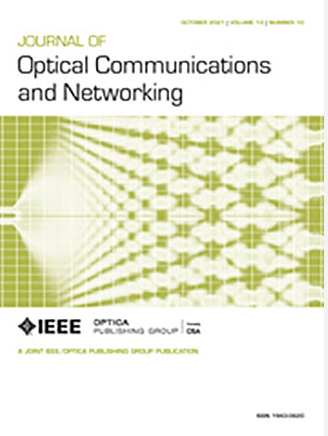用于EDFA增益谱建模的广义少弹迁移学习结构
IF 4.3
2区 计算机科学
Q1 COMPUTER SCIENCE, HARDWARE & ARCHITECTURE
引用次数: 0
摘要
掺铒光纤放大器(edfa)增益谱的精确建模对于优化光网络性能至关重要,特别是当网络向多供应商解决方案发展时。在这项工作中,我们提出了一种基于半监督自归一化神经网络(SS-NN)的广义少射迁移学习架构,该架构利用内部EDFA特征(如VOA输入/输出功率和衰减)来改进增益谱预测。我们的SS-NN模型采用两阶段训练策略,包括带有噪声增强测量的无监督预训练和带有自定义加权MSE损失的监督微调。此外,我们使用迁移学习(TL)技术扩展了框架,该技术可以在助推器,前置放大器和ILA edfa之间实现同质(相同特征空间)和异质(不同特征集)模型适应。为了解决异构TL中的特征不匹配问题,我们结合了协方差匹配损失来对齐源域和目标域之间的二阶特征统计。在COSMOS和Open Ireland的26个edfa测试平台上进行的大量实验表明,与基准方法相比,所提出的方法显着减少了系统的测量需求数量,同时实现了更低的平均绝对误差和改进的误差分布。本文章由计算机程序翻译,如有差异,请以英文原文为准。
Generalized few-shot transfer learning architecture for modeling the EDFA gain spectrum
Accurate modeling of the gain spectrum in erbium-doped fiber amplifiers (EDFAs) is essential for optimizing optical network performance, particularly as networks evolve toward multi-vendor solutions. In this work, we propose a generalized few-shot transfer learning architecture based on a semi-supervised self-normalizing neural network (SS-NN) that leverages internal EDFA features—such as VOA input/output power and attenuation—to improve gain spectrum prediction. Our SS-NN model employs a two-phase training strategy comprising unsupervised pre-training with noise-augmented measurements and supervised fine-tuning with a custom-weighted MSE loss. Furthermore, we extend the framework with transfer learning (TL) techniques that enable both homogeneous (same-feature space) and heterogeneous (different-feature sets) model adaptation across booster, pre-amplifier, and ILA EDFAs. To address feature mismatches in heterogeneous TL, we incorporate a covariance matching loss to align second-order feature statistics between the source and target domains. Extensive experiments conducted across 26 EDFAs in the COSMOS and Open Ireland testbeds demonstrate that the proposed approach significantly reduces the number of measurement requirements on the system while achieving lower mean absolute errors and improved error distributions compared to benchmark methods.
求助全文
通过发布文献求助,成功后即可免费获取论文全文。
去求助
来源期刊
CiteScore
9.40
自引率
16.00%
发文量
104
审稿时长
4 months
期刊介绍:
The scope of the Journal includes advances in the state-of-the-art of optical networking science, technology, and engineering. Both theoretical contributions (including new techniques, concepts, analyses, and economic studies) and practical contributions (including optical networking experiments, prototypes, and new applications) are encouraged. Subareas of interest include the architecture and design of optical networks, optical network survivability and security, software-defined optical networking, elastic optical networks, data and control plane advances, network management related innovation, and optical access networks. Enabling technologies and their applications are suitable topics only if the results are shown to directly impact optical networking beyond simple point-to-point networks.

 求助内容:
求助内容: 应助结果提醒方式:
应助结果提醒方式:


